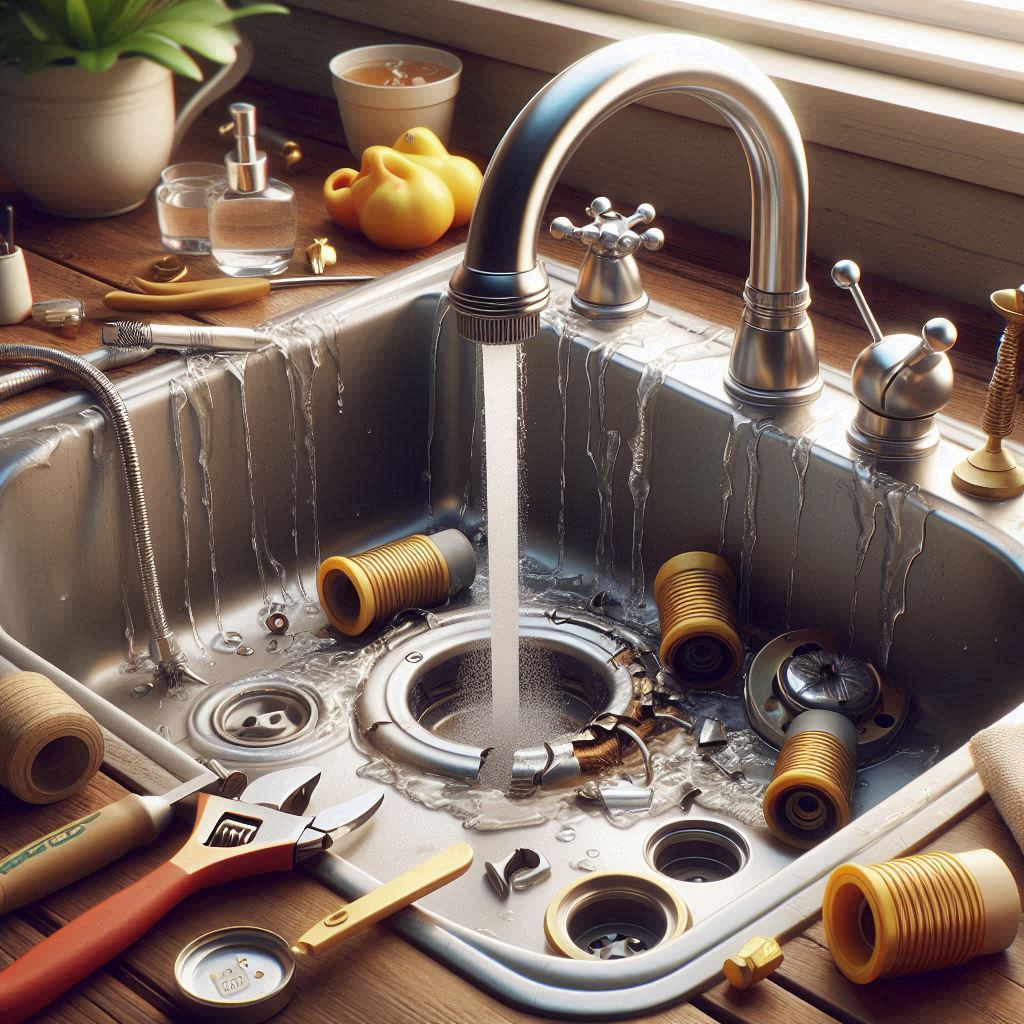Phone: (559) 272-4265
Appliance Repair Tips For Bakersfield, CA Residents

Stop That Drip: Delta Kitchen Faucet Leak Repair
“With the right know-how, repairing a Delta kitchen faucet leak (single handle) is easier than you think—keep your kitchen running smoothly with our simple guide!” - Appliance Boss
Introduction:
The rhythmic sound of a dripping kitchen faucet can become more than just a minor annoyance—it can hint at a larger problem lurking within your plumbing system. Delta kitchen faucets, known for their innovation and quality, may experience leaks over time due to regular wear and tear. By addressing these leaks swiftly, you can avoid water wastage, prevent potential damage to your kitchen, and save money in the long run. Let's delve into the details of troubleshooting and repairing leaks in your Delta kitchen faucet.

Understanding Delta Kitchen Faucets
Delta kitchen faucets stand out for their variety of styles and functionalities, offering solutions to match your kitchen decor and cooking needs. These faucets may feature single or dual handles, pull-down sprayers, and touchless technology. Familiarizing yourself with your specific Delta model will help you navigate the repair process with greater ease.
Common Reasons for Leaks in Delta Kitchen Faucets
Dripping Spout
The most obvious sign of a faucet leak is a dripping spout, which can quickly become a source of frustration. This issue is often caused by a worn-out cartridge, loose fittings, or debris buildup inside the faucet. A constant drip not only wastes water but can also create unsightly stains on your sink.
Leaking Base
A leak at the base of the faucet can result in water pooling around the sink, leading to potential damage to your countertops and cabinetry. This type of leak is typically due to deteriorated seals, loose mounting nuts, or corrosion around the faucet base.
Spray Hose Leaks
Delta faucets with pull-down or pull-out spray hoses may experience leaks where the hose connects to the faucet. The hose itself may develop cracks or splits, causing water to escape unexpectedly and reducing its functionality.
Faulty Cartridge
The cartridge within the faucet plays a vital role in controlling water flow and temperature. A malfunctioning cartridge may result in inconsistent water pressure, temperature fluctuations, or unexpected leaks. Identifying and replacing a faulty cartridge can restore your faucet's performance.
Tools and Materials You Will Need
To tackle repairs effectively, gather the following essential tools and materials:
Wrenches
Adjustable and basin wrenches are vital for loosening and tightening various parts of the faucet, especially in tight spaces.
Screwdrivers
A set of screwdrivers in different sizes will help you disassemble the faucet and access its internal components.
Plumber's Tape
Also known as Teflon tape, plumber's tape creates a secure seal around threaded connections to prevent leaks.
Replacement Parts
Depending on the repair required, keep replacement parts on hand, such as cartridges, seals, or hoses.
Towels and Bucket
Towels help absorb any water spillage, while a bucket can catch drips and prevent a mess during the repair process.
Preparing Your Workspace
Turning Off Water Supply
Begin by shutting off the water supply to the sink. Locate the valves beneath the sink and turn them clockwise to stop the flow. This precaution is essential to prevent water from gushing out during repairs.
Clearing the Sink Area
Create a clean, dry workspace around your sink by removing any items and cleaning the area. Place towels around the sink to catch any spills.
Gathering Necessary Tools and Parts
Ensure all tools and replacement parts are within reach for a smooth and efficient repair process. This preparation saves time and minimizes interruptions.
Inspecting the Delta Faucet
Checking for Visible Leaks
Visually inspect the faucet for signs of leaks, including water stains, corrosion, and moisture around the base, handle, or spray hose.
Locating the Source of the Leak
Pinpoint the exact source of the leak by observing where water is escaping. This will guide your repair efforts and help you identify the necessary parts to replace.
Identifying Worn-Out Parts
Inspect the faucet's components for signs of wear, such as cracks, discoloration, or buildup. Pay close attention to seals, cartridges, and hoses.
How to Repair a Dripping Spout
Removing the Handle
To access the cartridge, start by removing the faucet handle. Locate the set screw underneath or on the side of the handle and use a screwdriver or Allen wrench to loosen it. Gently lift the handle off.
Accessing the Cartridge
With the handle removed, you can access the cartridge. Observe its orientation before removing it to ensure the new cartridge is installed correctly.
Replacing the Cartridge
Install a new cartridge in the same orientation as the old one. Press it firmly into place and ensure it is secure.
Reassembling the Faucet
Reassemble the faucet by replacing the handle and tightening the set screw. Check for proper alignment and secure all connections.
Fixing Leaks at the Base
Tightening Loose Connections
Check connections around the base of the faucet for looseness. Use a wrench to tighten them as needed, being careful not to overtighten and cause damage.
Replacing Worn Out Seals
If the base continues to leak, inspect and replace seals that appear worn or damaged. A new seal can create a watertight barrier.
Checking for Corrosion
Examine the base of the faucet for signs of corrosion, which can contribute to leaks. Clean or replace affected parts as necessary.
Troubleshooting Spray Hose Leaks
Examining the Spray Hose Connection
Check the spray hose connection for tightness and proper alignment. Ensure the connection is secure and not causing leaks.
Checking for Cracks or Damage
Inspect the spray hose for cracks, splits, or other damage. If found, replace the hose to maintain optimal function.
Replacing the Spray Hose
If the hose is beyond repair, remove it from the faucet and replace it with a new one. Follow the manufacturer's instructions for installation.
Resolving Cartridge Issues
Identifying Signs of Cartridge Failure
A faulty cartridge can cause problems such as inconsistent water pressure or temperature. Look for signs such as water leaking from the handle or uneven water flow.
Steps for Replacing the Cartridge
Replace a faulty cartridge by following the same steps as you would for repairing a dripping spout. Ensure the new cartridge is properly installed and secured.
Testing the Repair
After replacing the cartridge, turn on the water supply and test the faucet. Observe for smooth water flow and consistent temperature.
Checking and Maintaining Water Pressure
Adjusting Pressure Regulator
If water pressure is too high or low, adjust the pressure regulator to achieve a comfortable and efficient flow. Consult your faucet's manual for specific instructions.
Cleaning Aerators
Aerators can become clogged with mineral deposits over time, affecting water flow. Remove and clean the aerator regularly to maintain optimal pressure.
Regular Maintenance for Optimal Flow
Incorporate regular maintenance into your routine, such as cleaning aerators and checking for leaks, to ensure your faucet functions properly.
Testing for Leaks and Proper Functioning
Turning on Water Supply
After completing repairs, turn the water supply back on and observe the faucet for any remaining leaks.
Checking for Remaining Leaks
Look closely at all areas of the faucet for signs of leaks. If any are found, address them promptly to avoid further issues.
Ensuring Smooth Operation
Test the faucet's operation, including the spray hose, to ensure it runs smoothly and without any issues.
When to Call a Professional Plumber
Recognizing Complex Issues
If you encounter persistent problems or issues beyond your expertise, consider calling a professional plumber in Bakersfield for assistance.
Signs of Advanced Damage
Watch for signs of severe damage, such as extensive corrosion, broken parts, or structural issues that may require professional intervention.
Importance of Expert Repair
Professional plumbers have the expertise and specialized tools to handle complex repairs, ensuring your faucet is restored to optimal working condition.
Tips for Preventing Future Leaks
Regular Maintenance
Routine maintenance, such as cleaning aerators and checking seals, can help prevent future leaks and extend the lifespan of your faucet.
Avoiding Excessive Force
Handle your faucet with care and avoid excessive force to prevent damage to its components.
Checking and Replacing Parts Periodically
Periodically inspect your faucet for signs of wear and replace any worn-out parts to maintain its efficiency.
Conclusion
Repairing a Delta kitchen faucet leak may initially seem like a daunting task, but with the right knowledge and tools, it becomes a manageable and rewarding experience. By addressing leaks promptly and practicing regular maintenance, you can extend the lifespan of your faucet and maintain a pristine kitchen. Take pride in your newfound plumbing skills and enjoy the peace of a drip-free sink. And if you ever need assistance, don't hesitate to schedule a service appointment with Zip Appliance and Plumbing Repair in Bakersfield for expert care and support.
Our company, Zip Appliance and Plumbing Repair, offers reliable services to ensure your plumbing systems are running smoothly. Visit our website at www.ziprepairservice.com for more information or contact us at (661) 387-2282 for any plumbing issues. We're here to help you maintain a leak-free and efficient home.

Stop That Drip: Delta Kitchen Faucet Leak Repair
“With the right know-how, repairing a Delta kitchen faucet leak (single handle) is easier than you think—keep your kitchen running smoothly with our simple guide!” - Appliance Boss
Introduction:
The rhythmic sound of a dripping kitchen faucet can become more than just a minor annoyance—it can hint at a larger problem lurking within your plumbing system. Delta kitchen faucets, known for their innovation and quality, may experience leaks over time due to regular wear and tear. By addressing these leaks swiftly, you can avoid water wastage, prevent potential damage to your kitchen, and save money in the long run. Let's delve into the details of troubleshooting and repairing leaks in your Delta kitchen faucet.

Understanding Delta Kitchen Faucets
Delta kitchen faucets stand out for their variety of styles and functionalities, offering solutions to match your kitchen decor and cooking needs. These faucets may feature single or dual handles, pull-down sprayers, and touchless technology. Familiarizing yourself with your specific Delta model will help you navigate the repair process with greater ease.
Common Reasons for Leaks in Delta Kitchen Faucets
Dripping Spout
The most obvious sign of a faucet leak is a dripping spout, which can quickly become a source of frustration. This issue is often caused by a worn-out cartridge, loose fittings, or debris buildup inside the faucet. A constant drip not only wastes water but can also create unsightly stains on your sink.
Leaking Base
A leak at the base of the faucet can result in water pooling around the sink, leading to potential damage to your countertops and cabinetry. This type of leak is typically due to deteriorated seals, loose mounting nuts, or corrosion around the faucet base.
Spray Hose Leaks
Delta faucets with pull-down or pull-out spray hoses may experience leaks where the hose connects to the faucet. The hose itself may develop cracks or splits, causing water to escape unexpectedly and reducing its functionality.
Faulty Cartridge
The cartridge within the faucet plays a vital role in controlling water flow and temperature. A malfunctioning cartridge may result in inconsistent water pressure, temperature fluctuations, or unexpected leaks. Identifying and replacing a faulty cartridge can restore your faucet's performance.
Tools and Materials You Will Need
To tackle repairs effectively, gather the following essential tools and materials:
Wrenches
Adjustable and basin wrenches are vital for loosening and tightening various parts of the faucet, especially in tight spaces.
Screwdrivers
A set of screwdrivers in different sizes will help you disassemble the faucet and access its internal components.
Plumber's Tape
Also known as Teflon tape, plumber's tape creates a secure seal around threaded connections to prevent leaks.
Replacement Parts
Depending on the repair required, keep replacement parts on hand, such as cartridges, seals, or hoses.
Towels and Bucket
Towels help absorb any water spillage, while a bucket can catch drips and prevent a mess during the repair process.
Preparing Your Workspace
Turning Off Water Supply
Begin by shutting off the water supply to the sink. Locate the valves beneath the sink and turn them clockwise to stop the flow. This precaution is essential to prevent water from gushing out during repairs.
Clearing the Sink Area
Create a clean, dry workspace around your sink by removing any items and cleaning the area. Place towels around the sink to catch any spills.
Gathering Necessary Tools and Parts
Ensure all tools and replacement parts are within reach for a smooth and efficient repair process. This preparation saves time and minimizes interruptions.
Inspecting the Delta Faucet
Checking for Visible Leaks
Visually inspect the faucet for signs of leaks, including water stains, corrosion, and moisture around the base, handle, or spray hose.
Locating the Source of the Leak
Pinpoint the exact source of the leak by observing where water is escaping. This will guide your repair efforts and help you identify the necessary parts to replace.
Identifying Worn-Out Parts
Inspect the faucet's components for signs of wear, such as cracks, discoloration, or buildup. Pay close attention to seals, cartridges, and hoses.
How to Repair a Dripping Spout
Removing the Handle
To access the cartridge, start by removing the faucet handle. Locate the set screw underneath or on the side of the handle and use a screwdriver or Allen wrench to loosen it. Gently lift the handle off.
Accessing the Cartridge
With the handle removed, you can access the cartridge. Observe its orientation before removing it to ensure the new cartridge is installed correctly.
Replacing the Cartridge
Install a new cartridge in the same orientation as the old one. Press it firmly into place and ensure it is secure.
Reassembling the Faucet
Reassemble the faucet by replacing the handle and tightening the set screw. Check for proper alignment and secure all connections.
Fixing Leaks at the Base
Tightening Loose Connections
Check connections around the base of the faucet for looseness. Use a wrench to tighten them as needed, being careful not to overtighten and cause damage.
Replacing Worn Out Seals
If the base continues to leak, inspect and replace seals that appear worn or damaged. A new seal can create a watertight barrier.
Checking for Corrosion
Examine the base of the faucet for signs of corrosion, which can contribute to leaks. Clean or replace affected parts as necessary.
Troubleshooting Spray Hose Leaks
Examining the Spray Hose Connection
Check the spray hose connection for tightness and proper alignment. Ensure the connection is secure and not causing leaks.
Checking for Cracks or Damage
Inspect the spray hose for cracks, splits, or other damage. If found, replace the hose to maintain optimal function.
Replacing the Spray Hose
If the hose is beyond repair, remove it from the faucet and replace it with a new one. Follow the manufacturer's instructions for installation.
Resolving Cartridge Issues
Identifying Signs of Cartridge Failure
A faulty cartridge can cause problems such as inconsistent water pressure or temperature. Look for signs such as water leaking from the handle or uneven water flow.
Steps for Replacing the Cartridge
Replace a faulty cartridge by following the same steps as you would for repairing a dripping spout. Ensure the new cartridge is properly installed and secured.
Testing the Repair
After replacing the cartridge, turn on the water supply and test the faucet. Observe for smooth water flow and consistent temperature.
Checking and Maintaining Water Pressure
Adjusting Pressure Regulator
If water pressure is too high or low, adjust the pressure regulator to achieve a comfortable and efficient flow. Consult your faucet's manual for specific instructions.
Cleaning Aerators
Aerators can become clogged with mineral deposits over time, affecting water flow. Remove and clean the aerator regularly to maintain optimal pressure.
Regular Maintenance for Optimal Flow
Incorporate regular maintenance into your routine, such as cleaning aerators and checking for leaks, to ensure your faucet functions properly.
Testing for Leaks and Proper Functioning
Turning on Water Supply
After completing repairs, turn the water supply back on and observe the faucet for any remaining leaks.
Checking for Remaining Leaks
Look closely at all areas of the faucet for signs of leaks. If any are found, address them promptly to avoid further issues.
Ensuring Smooth Operation
Test the faucet's operation, including the spray hose, to ensure it runs smoothly and without any issues.
When to Call a Professional Plumber
Recognizing Complex Issues
If you encounter persistent problems or issues beyond your expertise, consider calling a professional plumber in Bakersfield for assistance.
Signs of Advanced Damage
Watch for signs of severe damage, such as extensive corrosion, broken parts, or structural issues that may require professional intervention.
Importance of Expert Repair
Professional plumbers have the expertise and specialized tools to handle complex repairs, ensuring your faucet is restored to optimal working condition.
Tips for Preventing Future Leaks
Regular Maintenance
Routine maintenance, such as cleaning aerators and checking seals, can help prevent future leaks and extend the lifespan of your faucet.
Avoiding Excessive Force
Handle your faucet with care and avoid excessive force to prevent damage to its components.
Checking and Replacing Parts Periodically
Periodically inspect your faucet for signs of wear and replace any worn-out parts to maintain its efficiency.
Conclusion
Repairing a Delta kitchen faucet leak may initially seem like a daunting task, but with the right knowledge and tools, it becomes a manageable and rewarding experience. By addressing leaks promptly and practicing regular maintenance, you can extend the lifespan of your faucet and maintain a pristine kitchen. Take pride in your newfound plumbing skills and enjoy the peace of a drip-free sink. And if you ever need assistance, don't hesitate to schedule a service appointment with Zip Appliance and Plumbing Repair in Bakersfield for expert care and support.
Our company, Zip Appliance and Plumbing Repair, offers reliable services to ensure your plumbing systems are running smoothly. Visit our website at www.ziprepairservice.com for more information or contact us at (661) 387-2282 for any plumbing issues. We're here to help you maintain a leak-free and efficient home.
If your dryer has been giving you problems, contact Zip Appliance Repair & Service at (661) 387-2282

Appliance Repair In A Zip
If you need a dryer repair call our Team at (661) 387-2282, or visit our online scheduling page to request service.
Appliance Repair
Plumbing Repair Services
HAVE A QUESTION, CALL (661) 387-2282

Online Offers
Take advantage of our online discount offers - save time and money...

Residential & Commercial appliances
See what our company can do for you

Appliance Repair Tips
If your appliance is not working properly...

1405 Commercial Way ste 100
Bakersfield, CA 93309
Lic # 1116346
Equipment We Sevice
- A Call To Confirm Your Appointment Time
- A Email Detailing Your Assigned Technician
- Information Needed Before The Repair Can Be Started
- An Estimate Of Work To Be Done
© 2024 ZIP APPLIANCE REPAIR & SERVICE LLC








